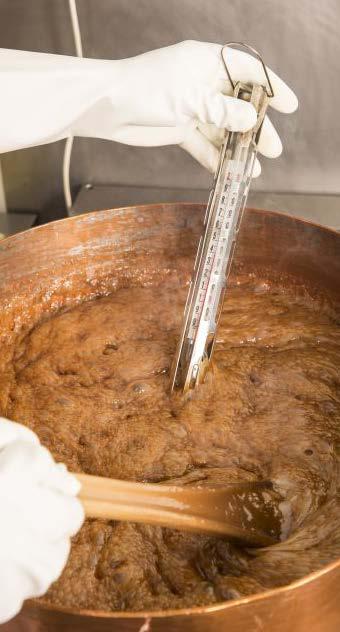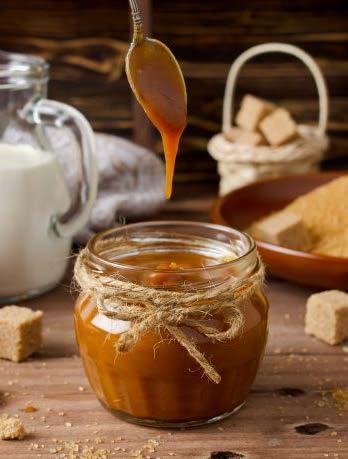
4 minute read
Making Goat Milk Caramels
Making Goat Milk Caramels By lacey HugHett
THIS FAST-APPROACHING holiday season has everyone scrambling to find some tasty, quality candy recipes. Have you tried making goat milk caramel? Heather Ische from Homestead Ranch provided me with a delicious caramel recipe, a little family history, and some good old-fashioned tips for making the best caramels around!
I tried the recipe and it was superb, a sweet, creamy take on a personal family favorite. Better yet, friends or family who are lactose intolerant can usually tolerate these sweets. This caramel isn’t as sweet as a traditional caramel so I found it perfect, particularly for my son, who generally can’t tolerate cow milk products.
Heather and Steven got their first goat in 2013 as a companion animal for a horse. They were instantly hooked. The first goat was a pet, and he acted just like a family dog. As their operation grew, the family looked for ways to monetize the goats in order to help with their cost of care. Although Heather was already making goat milk products, someone recommended creating caramel.
Goat milk and cheese products weren’t as widespread then as they are now. Heather wasn’t entirely sure where to start, but they had a family recipe to use as a base. After a huge amount of trial and error, she nailed down a perfect caramel recipe with goat milk, and now Heather is a wealth of knowledge and kindly shares it with our readers.
What began as a small operation quickly grew to around a 200-head herd of goats. Homestead Ranch raises mainly LaMancha goats, but they also include a few Nubian and Alpine goats. They breed for excellent milk lines and sell excess males for meat purposes. The key to a great operation is having multiple streams of income, which they have accomplished via milk products, body care products, and homegrown meat. The quality speaks for itself, so they’ve gathered a following of loyal customers.
The Homestead Ranch website, at www.allthingsranch.com, offers several high-quality recipes and tips for making these sweet treats. Heather advises using a heavy bottomed, large pan, and to only allow the caramel to fill ¾ of the way up the pan. The caramel froths while cooking and can easily spill over. I experienced this firsthand … it was enlightening.
Since caramels burn easily, Heather recommends copper cookware because it heats and cooks more evenly than any other medium. Other pans tend to have spotty heat coverage or heat too quickly. If the caramel becomes too hot, it will burn or the end product can become firmer than it should be.
Do not let the caramel sauce rise above 248 degrees F. Caramel is a “soft ball” class of candy. If you drop a ball of the cooking caramel sauce into a dish of cold water, it should form a soft, pliable ball of candy. For example, toffee and hard candy have different cooking temperatures because they are in the “hard ball” class, with temperatures ranging from 250-265 degrees F. When this type of candy is dropped into cool water, it becomes hard. If your caramel rises too high and goes into the hard ball range, you will no longer have those soft, delicious caramels you were dreaming about. I, too, have made this mistake. I don’t know what the end product is called; it tastes amazing, but it’s not caramel.
The easiest way to keep caramel at a good, constant heat is to invest in a copper pot and buy a candy thermometer. Heather has perfected these goat caramels and she stressed the importance of not letting it top 248 degrees F.

If you’re not feeling particularly adventurous, I have great news! Heather makes, sells, and ships her caramels from her website year-round. I’m excited to order a batch for myself and my family this fall season.
In addition to the goat milk caramel recipe below, Heather has recipes for cajeta (traditional Mexican caramel sauce — with cinnamon!), caramel pecan cheesecake, and goat milk ice cream on her website, among many others. Make sure to stop by for pictures, tips, or to order some yummy products. You can show a little love on her Facebook page, Homestead Ranch LLC, and thank her for sharing these traditional family recipes.
Since I’ve tantalized your taste buds, here is the recipe that Heather gave me, exclusively for our readers! Feel free to play with the recipe and experiment with different flavors. I love making caramel with a hint of espresso powder because I like the taste of coffee. Heather assured me that different flavors and ingredients can be added to customize the taste of the caramel. If you try this recipe, remember to utilize Heather’s advice and make sure to tell us how it turned out.

Homestead Ranch Goat Milk Caramels
INGREDIENTS ½ cup butter, cut into pieces 1 cup brown sugar ½ cup white sugar ¼ cup honey 1¼ cups goat milk 1¼ cups heavy cream 1¼ tablespoons vanilla extract Flaky sea salt, to finish. (Optional) Extra butter to coat baking dish
INSTRUCTIONS •Set a large pot over high heat. Combine butter, brown sugar, white sugar, honey, goat milk, and heavy cream. Stir mixture constantly while keeping candy thermometer partly submerged. When temperature reaches 248 degrees F, remove pot from heat. Add vanilla extract and stir. •Butter a separate baking dish. Pour mixture into buttered baking dish. Sprinkle salt over caramel. Let cool 30 minutes, and then transfer, uncovered, to refrigerator. Chill several hours until firm before cutting.
May your holiday season be filled with goat milk caramels and other treats — and be just a little bit sweeter! ◊






